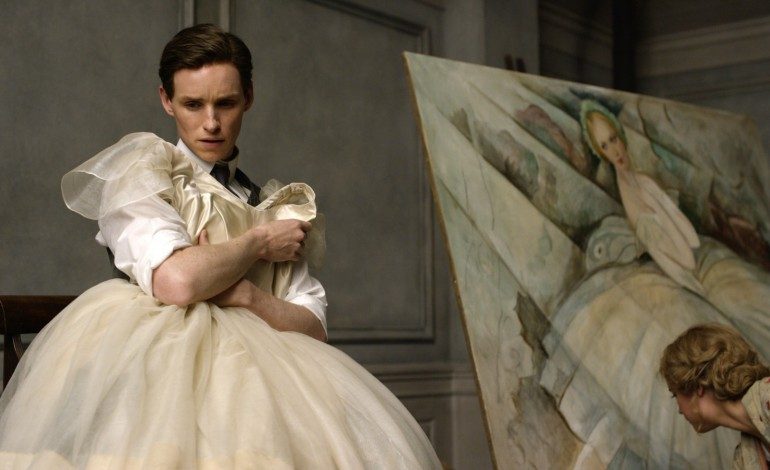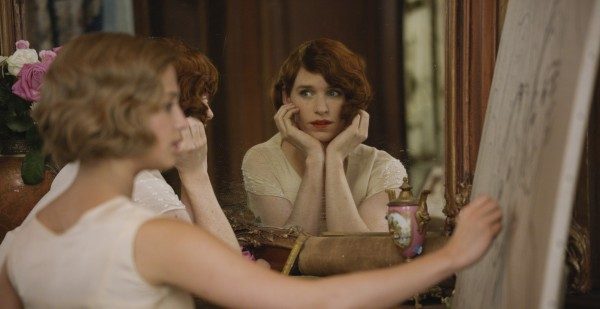

The Danish Girl is one of those dicey bits of filmmaking where it’s irresistibly admirable for existing outright even if its finished results are far from seamless. Therein lies the grey-tinted quandary of this biographical period drama centering around Lili Elbe, a transgender pioneer and one of the first in the world to undergo gender confirmation surgery. From a social, political and humanist viewpoint, The Danish Girl is endlessly commendable, perhaps even noble. From a dramatic perspective…well it may leave many wanting more- a dreary, commonplace problem for many a socially conscious piece of “art” that enters the fray towards the end of the year with gold statues in mind.
Directed by Tom Hooper with a similar drawing room sense of refinement which he brought to his Oscar-winning 2010 historical drama The King’s Speech, the movie comes neatly packaged with an impressive pedigree. Adapted from David Ebershoff’s acclaimed 2000 novel, The Danish Girl stars Eddie Redmayne- fresh from his Oscar-winning turn as Stephen Hawking in The Theory of Everything– and rising star Alicia Vikander (Ex Machina) as Einar and Gerda Wegener, real-life painters and bohemian spirits who were small hits on the Copenhagen art scene in the 1920s. From the easy-going opening, Einar and Gerda are presented as a rather gregarious, playful couple. Einar achieved some early success as a painter of landscapes while Gerda was portraitist; competition may have sparked and ribbed their marriage but never seemed to negatively impact their joie de vivre or their sex life despite the lack of a child in Gerda’s belly. Curiously, according to the movie, it was Gerda who first wooed Einar, an interesting piece of exposition for a period piece that questions gender.
Plotted as a lark once upon a time, Gerda requests that Einar pose with an elegantly designed gown draped upon him for one of her portraits. Not being a particular subtle piece of filmmaking, The Danish Girl shows its hand with an underlined sense of purpose- Einar is awakened and transfixed. Soon enough, Einar has one of Gerda’s undergarments underneath his suit; Hooper stages this nearly as foreplay. The lark begins a game as the couple doll Einar up fully, masquerading as visiting cousin Lili at an opulent ball; what a way to turn the heads of the bourgeoisie. Party girl friend Ulla (Amber Heard) thinks it’s a gas. This is no game for Einar, of course, who is forever altered and reinvigorated. One of the finest, more beautifully observed sequences of The Danish Girl finds Einar-as-Lili discovering firsthand both the allure and misfortune of the male gaze- fortunately Lili is gently courted by a compassionate gentleman named Henrik (Ben Whishaw, Spectre) instead of some kind of lecherous cad.
An even stronger scene shortly thereafter sees Einar stripping down completely in front a mirror as if to say a final goodbye to his male body. It goes without saying that Redmayne readily and respectfully commits to his role. So much, it nearly wipes away any misgivings one might have against the casting of a cisgendered performer in the part of an early trans-pioneer, one that existed long before their was any sort of language on the subject nor a community to speak of. The early quivers and tinges of delight, fear and reticence are captured in Redmayne’s face. Early scenes show Lili observing the women around him (including Gerda) taking quick note of their facial expressions and how they walk, a truthful and primal assessment of early gender identity. Redmayne makes it palpable and accessible, yet much like his performance in The Theory of Everything, the actor appears more interested and astute in the technical rather than the emotional.
Which marks The Danish Girl a fascinating, if asymmetrical essay on acting styles as Vikander, a rare mercurial presence seemingly from a bygone era that may have never existed, radiates from the inside out. The actress invests in Gerda a lived-in vitality, thoughtfulness and modern sensibility that veers drastically from Redmayne’s tastefully refined technique. It’s somewhat a shame and certainly a missed opportunity that Gerda is tasked with a fairly standard issue “supportive wife” role. Hooper and screenwriter Lucida Coxon attempt a semi-balanced perspective as Gerda’s portraits of Lili send the couple to Paris and a charming art dealer (played by Matthias Schoenaerts) starts to whisper sweet nothings. Tensions also start to arise as Lili decides to abandon art to try and focus solely on her newfound femininity- Gerda, with acidic aplomb, retorts that a woman can both. The title itself is uttered once and could- somewhat- stand in for both Lili and Gerda though the scale is tipped.
The ultimate undoing for The Danish Girl is that may just too tasteful for its own good in the end. The lovely musical score by Alexandre Desplat swells at the right places, Paco Delgado’s costume design is dutifully elegant and Danny Cohen’s camerawork is crisp and evocative yet The Danish Girl never quite fully jells on a purely emotionally level. There’s moments- many of them fleeting- where you think the movie is truly going to come alive, to deliver an emotional jolt but the utter respectability of the filmmaking keeps that at bay. The urge is to try and understand Lili and empathize what this experience must have felt like- various doctors pose as the villains of the piece scribbling notes of schizophrenia until a new-age physician (played by German actor Sebastian Koch) suggests surgery as an option- yet The Danish Girl is content to keep its distance.
Verdict: 3 out of 5
An accomplished piece of filmmaking on terms of acting and production elements, yet something is strangely missing at the core of The Danish Girl. What should be a groundbreaking and essential piece of cinema exploring one of the first people in the world to undergo gender confirmation surgery and how a transformation of this kind effected the marriage of two artists in the 1920s is a tad too stately, too polished and too gussied up for its own good. Director Tom Hooper simply plays it too safe. Still, even if graded on a curve, it’s an easy film to admire and an accessible primer for those sorely in need of its underlined message.



